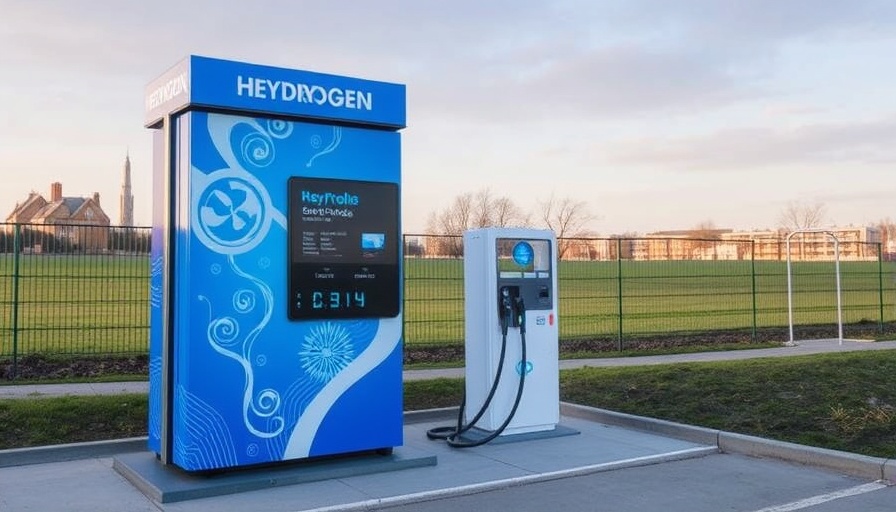
Revolutionizing Hydrogen Infrastructure: BAM's Role in Germany
The German Federal Institute for Materials Research and Testing (BAM) has recently taken a significant step forward in the hydrogen economy. The introduction of a research-focused hydrogen filling station represents a landmark project aimed at advancing quality assurance processes within this burgeoning technology sector. Located at the Technical Safety Test Site (TTS) in Horstwalde/Baruth, Brandenburg, BAM’s facility stands alone as the first of its kind in the nation, signaling a commitment to improving hydrogen infrastructure.
Harnessing Digital Technologies for Enhanced Safety
BAM's research station isn't just about filling hydrogen; it embodies the future of hydrogen technology through its focus on innovation and safety. Utilizing cutting-edge digital monitoring tools, it aims to streamline all technical processes involved in hydrogen refueling. With sensors capturing real-time operational data, BAM is set to leverage this information to develop digital twins—virtual models that simulate real-life conditions to assess performance and safety metrics over time.
A Step Towards Sustainable Hydrogen Production
Importantly, the hydrogen supplied at this facility is sourced from a green electrolyser powered by renewable energy. Initially, green hydrogen will be delivered to the station, but the long-term vision includes a self-sustaining system fueled entirely by solar power. As the world pivots toward sustainable energy solutions, BAM’s dedication to using clean energy methods is a notable benchmark for similar future projects.
Public Acceptance and Infrastructure Advancement
One of the critical goals behind BAM's research is to improve the overall acceptance of hydrogen technology among the public. By ensuring enhanced quality assurance and optimized processes, BAM's innovations aim to boost the reliability and cost-effectiveness of hydrogen stations. This should lead to a greater integration of hydrogen vehicles (FCEVs) into everyday life, potentially transforming consumer perceptions and fostering an eco-friendly transportation ecosystem.
Collaborative Efforts for Industry Progress
Engagement with various industries is a fundamental aspect of this project. BAM is collaborating with industry stakeholders, SMEs, and startups to research diverse questions related to safety and operational efficiency. This cooperation could lead to improved maintenance cycles, critical condition detection, and elevated safety standards—essential components for the future of reliable hydrogen infrastructure.
Trends in Digital Quality Assurance for Hydrogen Stations
As part of the 'Digital Quality Infrastructure' initiative, BAM is positioning itself as a leader in exploring and advancing the digital dimensions of hydrogen technology. Research topics at the station will include digital process mapping, online safety monitoring, and predictive maintenance techniques. By pioneering these methodologies, BAM aims to define a new standard for hydrogen filling stations, enhancing both safety and operational performance.
The Bigger Picture: Hydrogen's Role in Green Energy
The establishment of this research station comes at a pivotal moment as countries worldwide intensify their focus on greener energy solutions. The European Union, for example, is investing heavily in hydrogen as part of its strategy to achieve carbon neutrality by 2050. As hydrogen technology matures, the integration of solar energy solutions with hydrogen production will likely play a crucial role in meeting these ambitious environmental targets.
Moving Forward: The Future of Hydrogen Technology
The research station at BAM is more than just an experiment; it’s a gateway to a sustainable future. The implications of this project extend far beyond Germany. If successful, it could inspire similar initiatives globally, encouraging other countries to adopt hydrogen technology as a viable solution within their energy frameworks.
Homeowners and businesses eager to transition to green energy should closely monitor developments like these. The implications for infrastructure and technology advancements in renewable energy will be profound, presenting numerous opportunities in sustainable living and energy independence. As we see projects like BAM's hydrogen filling station advance, it becomes clear that the future is not just electric; it’s a harmonious blend of hydrogen and solar energy.
 Add Row
Add Row  Add
Add 






Write A Comment